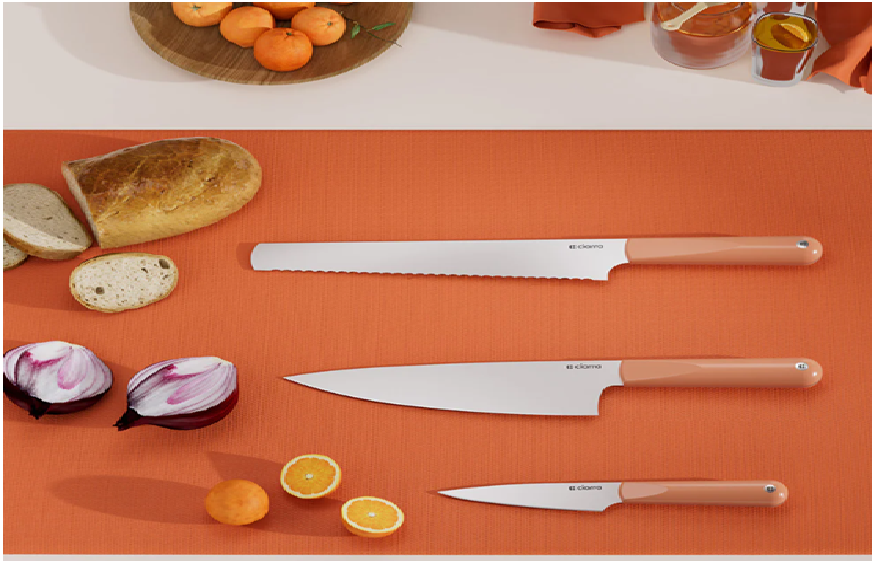Complete Guide to Knife Sets: Types, Uses, Cleaning, and Sanitization

A well-crafted knife set is a crucial addition to any kitchen, whether at home, in a professional restaurant, or for outdoor adventures. Understanding the different knives in a set, how they are used, and how to properly care for them can significantly enhance the experience of cooking and food preparation. This article covers the essential types of knives typically found in a knife set, their roles, and the proper methods for cleaning, sterilizing, and maintaining them, particularly focusing on the differences in material and usage context.
Types of Knives in a Knife Set
A knife set typically includes several types of knives, each designed to fulfill specific tasks in the kitchen. The main knives found in most sets include:
1. Chef’s Knife
Role and Application: The most versatile knife in any set, the chef’s knife has a broad, curved blade designed for chopping, slicing, dicing, and mincing. Its size and shape make it ideal for almost every cutting task, from vegetables to meats.
Common Use: Chopping vegetables, slicing meat, dicing onions, and mincing garlic.
2. Paring Knife
Role and Application: Small and nimble, the paring knife is used for intricate tasks that require precision, such as peeling, trimming, and coring. Its short blade allows for fine control.
Common Use: Peeling fruit, deveining shrimp, trimming fat from meat.
3. Serrated Knife (Bread Knife)
Role and Application: A long, serrated blade is ideal for cutting through foods with tough exteriors and soft interiors, such as bread, tomatoes, and cakes. The saw-like edge allows for easy slicing without crushing the food.
Common Use: Slicing bread, cutting cake layers, and tomatoes.
4. Utility Knife
Role and Application: This knife is a mid-sized option that falls between a chef’s knife and a paring knife. It’s versatile for cutting sandwiches, fruits, and vegetables, especially when a chef’s knife might be too large.
Common Use: Slicing cheese, cutting sandwiches, and chopping small vegetables.
5. Boning Knife
Role and Application: With a thin, flexible blade, the boning knife is specifically designed to remove meat from bones. It can be used for filleting fish and breaking down poultry or meat cuts.
Common Use: Deboning chicken, filleting fish, cutting through cartilage.
6. Santoku Knife
Role and Application: This Japanese knife is similar to a chef’s knife but has a flatter blade and a slightly different cutting technique. It excels at chopping, dicing, and mincing, especially for Asian cuisines.
Common Use: Chopping vegetables, slicing meat, mincing herbs.
7. Carving Knife
Role and Application: A long, narrow blade designed for slicing through cooked meats like roast beef, turkey, or ham. It allows for thin, even slices.
Common Use: Carving roast meats, slicing large cuts of meat.
Knife Sets Across Different Environments
While the knives in a set are largely the same, the way they are used varies depending on the setting: home kitchens, professional kitchens, and outdoor activities.
1. Home Use
Knife sets for home kitchens are typically designed to be versatile, offering a mix of essential knives that cover the most common cooking tasks. These sets may be smaller, with fewer pieces, but the focus is on ease of use and comfort.
Common Knives: Chef’s knife, paring knife, serrated knife, and utility knife.
Usage: Home cooks often need a smaller set with the basics to handle everyday meal prep.
2. Professional Catering
Professional kitchens use high-quality, durable knife sets with specialized knives. The sets often include a broader range of tools, such as boning knives, filleting knives, and carving knives, to accommodate the varied tasks chefs face daily.
Common Knives: Chef’s knife, boning knife, filleting knife, paring knife, and carving knife.
Usage: Chefs may require a wider selection to perform specialized tasks efficiently and with precision.
3. Outdoor Use (Camping, Hunting, Fishing)
Outdoor knife sets are designed for durability and portability. These knives often include larger, rugged blades suited for tasks like skinning, cutting rope, and preparing food in the wilderness.
Common Knives: Fixed-blade knives, fillet knives, and multi-purpose knives.
Usage: Outdoor knife sets are meant to withstand tough conditions and handle heavy-duty tasks, like preparing game or food over a campfire.
Cleaning and Sterilizing Your Knife Set
Maintaining a knife set requires proper cleaning and sanitization to ensure longevity and safe usage. Here’s a step-by-step guide to cleaning and sterilizing your knives.
Step-by-Step Process for Cleaning a Knife Set:
Initial Wipe Down: After each use, immediately wipe the blade with a damp cloth to remove any debris or food particles. This prevents food from sticking and minimizes the risk of contamination.
Rinse Under Warm Water: Hold the knife under warm, running water to remove any residual food. Avoid using hot water, as this can damage the blade’s surface or cause rusting.
Apply Dish Soap: Use a mild dish soap and a non-abrasive sponge to scrub the blade. Focus on the spine, edge, and handle. For stubborn food remnants, use a toothbrush to gently scrub.
Dry Thoroughly: After washing, dry the blade immediately with a soft towel to prevent water spots or rust.
Deep Cleaning (Occasionally): For knives that have accumulated heavy grease or residue, use a specialized knife cleaning product or a vinegar-water solution (1 part vinegar to 3 parts water). Let the knife sit in the solution for a few minutes, then scrub and rinse it off.
Methods of Sanitizing Knife Sets
Sanitizing is a more thorough process that helps kill bacteria, ensuring your knives are safe to use, especially in professional or food-sensitive environments.
Boiling Water: A quick and effective method for sanitizing your knives is to dip them briefly in boiling water. This method is best for stainless steel knives but should be avoided with high-carbon steel, as it can cause corrosion.
Alcohol Wipes: Wiping down your knives with a solution containing at least 70% isopropyl alcohol is a convenient way to sanitize the blade and handle.
Dishwasher: While some knives are dishwasher safe, it’s generally not recommended for high-quality or delicate knives, as the harsh detergents and high temperatures can damage the blade or handle.
Tips for Sanitizing Different Materials:
Stainless Steel: Stainless steel is resistant to rust and can handle most sanitizing methods. However, avoid long exposure to harsh chemicals or excessive heat.
Carbon Steel: Carbon steel knives are more susceptible to rust. Use a damp cloth with mild detergent to clean, and avoid boiling water or alcohol, as it may damage the blade’s surface.
Damascus Steel: Damascus steel requires gentle care. Only use a mild soap and cloth for cleaning, and always dry thoroughly after washing to prevent rusting.
Material-Specific Cleaning and Sterilization
Different materials require different care to maintain their quality and performance. Here’s how to care for knives made of various materials:
Stainless Steel Knives
Cleaning: These knives are the most forgiving and can be cleaned using standard methods like dish soap and water. Stainless steel does not rust easily, but prolonged exposure to moisture can cause staining.
Sterilizing: Alcohol wipes or a short dip in boiling water are safe options for sanitizing stainless steel knives.
Carbon Steel Knives
Cleaning: Carbon steel requires more care. After each use, dry the knife immediately to prevent rust. Use a mild soap solution and avoid soaking the knife.
Sterilizing: Avoid high temperatures and harsh chemicals. Wipe the blade with a soft cloth soaked in a mixture of water and vinegar to sanitize.
Ceramic Knives
Cleaning: Ceramic knives should be cleaned with mild detergent and warm water. Avoid using abrasive sponges, as they may scratch the blade.
Sterilizing: These knives can be sanitized with alcohol wipes. Do not expose ceramic knives to extreme temperatures.
Related: when must a knife be cleaned and sanitized
Conclusion
A knife set is an essential investment in any kitchen, and understanding the different types of knives, their uses, and proper maintenance is crucial for their longevity and effectiveness. Whether you’re using them at home, in a professional setting, or outdoors, proper care, cleaning, and sanitization are necessary to ensure your knives remain sharp, functional, and safe. By following the correct procedures for each material type, you can extend the life of your knife set and ensure optimal performance with every use.






